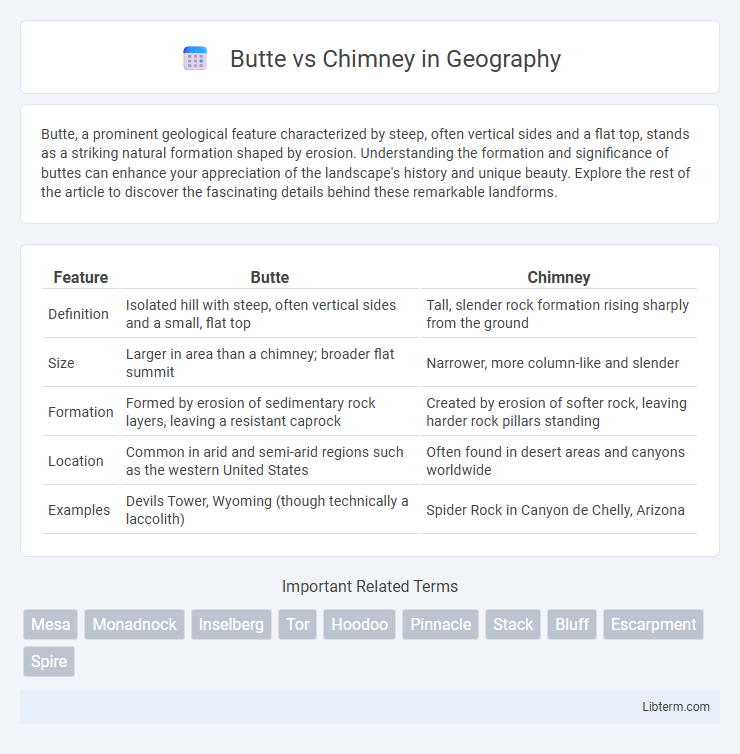Butte, a prominent geological feature characterized by steep, often vertical sides and a flat top, stands as a striking natural formation shaped by erosion. Understanding the formation and significance of buttes can enhance your appreciation of the landscape's history and unique beauty. Explore the rest of the article to discover the fascinating details behind these remarkable landforms.
Table of Comparison
| Feature | Butte | Chimney |
|---|---|---|
| Definition | Isolated hill with steep, often vertical sides and a small, flat top | Tall, slender rock formation rising sharply from the ground |
| Size | Larger in area than a chimney; broader flat summit | Narrower, more column-like and slender |
| Formation | Formed by erosion of sedimentary rock layers, leaving a resistant caprock | Created by erosion of softer rock, leaving harder rock pillars standing |
| Location | Common in arid and semi-arid regions such as the western United States | Often found in desert areas and canyons worldwide |
| Examples | Devils Tower, Wyoming (though technically a laccolith) | Spider Rock in Canyon de Chelly, Arizona |
Introduction to Buttes and Chimneys
Buttes are isolated hills with steep, often vertical sides and a small, flat top, formed by erosion-resistant rock layers protecting softer layers beneath. Chimneys, also known as hoodoos, are tall, thin spires of rock that rise from the ground, created through differential erosion where harder rock caps a column of softer rock. Both landforms exemplify unique erosion patterns but differ significantly in shape, size, and geological formation processes.
Geological Formation: Buttes vs Chimneys
Buttes are isolated hills with steep, often vertical sides and a small, flat top formed through erosion that isolates them from surrounding terrain, commonly found in arid regions like the American Southwest. Chimneys, also known as hoodoos or earth pyramids, are slender, tall rock formations created by differential erosion, where harder rock caps protect softer rock columns from weathering. Both features result from sedimentary rock layers being sculpted by wind and water, but buttes are larger and more block-like, whereas chimneys are narrow and tower-like.
Physical Characteristics and Differences
A butte is an isolated hill with steep, often vertical sides and a small, flat top, typically taller than wide, formed through erosion. A chimney, also known as a pinnacle or spire, is a slender, tower-like rock formation rising sharply from the ground, usually narrower and more elongated than a butte. The primary difference lies in their shape and size, with buttes having broader, flat summits and chimneys exhibiting narrow, pointed structures.
Examples of Famous Buttes Around the World
Monument Valley in the United States is home to some of the most iconic buttes, such as the Mittens, which rise dramatically from the valley floor. The Devil's Tower in Wyoming, although often mistaken for a chimney, is a famous volcanic butte known for its unique columnar jointing. Australia's Uluru, also known as Ayers Rock, is a massive sandstone butte that holds great cultural significance for the Anangu people.
Notable Chimney Structures in Nature
Notable chimney structures in nature, such as volcanic chimneys, form when magma solidifies within a vent, later exposed by erosion, creating towering rock columns. These chimneys often contrast sharply with buttes, which are isolated hills with steep sides and flat tops formed primarily by erosion of surrounding softer material. Famous natural chimneys include the Devil's Tower in Wyoming, characterized by its distinctive columnar jointing, showcasing geological processes distinct from the sedimentary layering typical of buttes.
Erosion Processes Shaping Buttes and Chimneys
Buttes and chimneys are both landforms shaped by erosion, primarily through differential weathering and water runoff. Buttes are characterized by their broad, flat tops and steep, vertical sides formed when softer surrounding rock erodes away, leaving harder rock intact. Chimneys, or hoodoos, develop as narrow, pillar-like structures where erosion removes the less resistant rock layers around a harder caprock, creating isolated spires.
Ecological Significance and Biodiversity
Buttes, characterized by isolated hills with steep, often vertical sides and a flat top, provide unique microhabitats that support specialized plant and animal species adapted to arid environments, enhancing local biodiversity. Chimneys, or rock spires, create vertical niches that serve as nesting sites for birds and refuge for small mammals, contributing to ecological complexity in otherwise uniform landscapes. Both geological formations act as critical biodiversity hotspots by offering varied microclimates and shelter, promoting the preservation of endemic species in fragile ecosystems.
Human Interaction and Cultural Importance
Buttes serve as prominent landmarks in many Indigenous cultures, often featuring in sacred rituals and storytelling traditions due to their isolated, striking appearance that fosters community identity. Chimneys, commonly found in volcanic regions, have historically influenced human settlement patterns by providing natural shelter and materials for tool-making, deeply intertwining with the daily lives and spiritual practices of local populations. Both landforms contribute significantly to cultural heritage, acting as symbols of resilience and connection to the natural environment.
Butte vs Chimney: Visual Identification Guide
A butte is a steep, isolated hill with a flat top and vertical or near-vertical sides, typically smaller than a mesa, while a chimney is a tall, narrow rock formation resembling a column or spire. Buttes are characterized by their broad, flat summits formed through erosion, distinguishing them visually from chimneys, which taper sharply and lack extensive flat surfaces. Recognizing the flat-topped, robust structure of a butte versus the slender, pillar-like shape of a chimney aids in accurate geological identification and landscape interpretation.
Summary: Key Differences Between Buttes and Chimneys
Buttes are isolated hills with steep, often vertical sides and a flat top, typically formed by erosion in arid regions, while chimneys are slender, vertical rock formations shaped by erosion that stand apart from buttes and mesas. Buttes generally have a larger surface area and more substantial mass compared to chimneys, which are narrower and more column-like. The primary difference lies in their shape and size-- buttes appear as flat-topped hills whereas chimneys resemble tall, thin spires.
Butte Infographic

 libterm.com
libterm.com